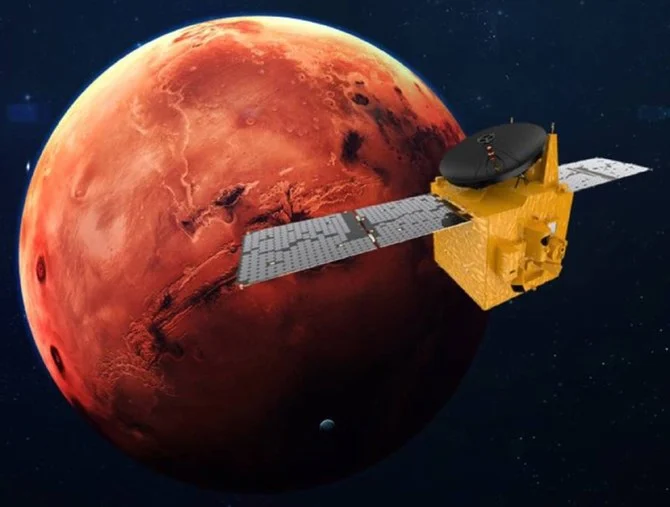Arab News
DUBAI: The Emirates Mars Mission, the first interplanetary exploration mission launched by an Arab nation, has discovered a new form of proton aurora around Mars, the Emirates News Agency reported.
Experts said the spatially variable “patchy” proton aurora could reveal new information about the Martian atmosphere. It was discovered in images captured by the Emirates Mars Ultraviolet Spectrometer, which monitors the planet’s upper atmosphere and exosphere
To fully analyze the observations, the EMM team collaborated with NASA’s Mars Atmosphere and Volatile Evolution mission, known as MAVEN for short. Experts said the combination of EMM’s unprecedented global aurora images and MAVEN’s concurrent local plasma observations open up new avenues for enhancing understanding of the planet’s enigmatic aurora.
“Our discovery of this patchy proton aurora adds a new kind of event to the long list of those currently studied by EMM and challenges our existing views of how the proton aurora on Mars’ dayside are formed,” said Hessa Al-Matroushi, EMM’s science lead.
“The EMM Hope probe has so far uncovered many unexpected phenomena that extend our understanding of Mars’ atmospheric and magnetospheric dynamics. These new observations, combined with MAVEN data, have lifted the lid on entirely new possibilities for scientific research.”
This newly observed patchy type of proton aurora is formed when the solar wind directly impacts Mars’ dayside upper atmosphere and emits ultraviolet light as it slows down.
Small regions of the planet become much brighter at these wavelengths when the aurora occurs, indicating intense localized energy deposition in the atmosphere.
“We’ve seen emissions at these wavelengths before, thanks to proton aurora studies by NASA’s MAVEN mission, but these EMM EMUS images represent the first time we’ve had a global view of spatial variability in proton aurora at Mars, and the first time we’ve been able to unambiguously observe this patchy structure,” said Mike Chaffin, a member of the EMM science team.
“We know that these wavelengths are only emitted by the hydrogen atom, which tells us that super energetic hydrogen atoms must be present in the atmosphere in order to produce the auroral emission.”
A data-sharing agreement between EMM and MAVEN allowed the new EMM images to be analyzed in conjunction with plasma observations made by MAVEN.
“Multi-vantage-point measurements of the Martian atmosphere tell us about the real-time response of the atmosphere to the Sun,” said Shannon Curry, MAVEN’s principal investigator. “These types of simultaneous observations probe the fundamental physics of atmospheric dynamics and evolution.”
Al-Matroushi added: “Access to MAVEN data has been essential for placing these new observations into a wider context. Together, we’re pushing the boundaries of our existing knowledge not only of Mars but of planetary interactions with the solar wind.”






















